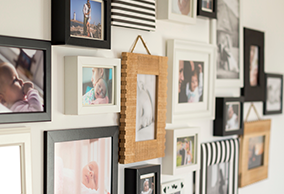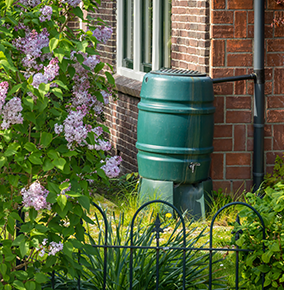


Bring Your Home to Life with a Gallery Wall

To avoid being a title fraud victim, read on for some tips.
- If you like clean lines, make a grid pattern of the same size and style pictures, or if you desire an eclectic look, use a mix of photos and art of different sizes and styles.
- For a pleasing aesthetic flair, use a cohesive color scheme or repeat two to three colors and styles.
- Float mount your art to elevate its impact.
- Before hanging, create the layout of your gallery wall on the floor, and space each piece about 3 inches apart.
For eclectic-looking gallery walls:
- Place one large piece of art off-center so it’s not the entire focal point and place the second largest piece separate from it on a diagonal for balance.
- Include a mini grid with up to four pictures of the same size, style, and frame aligned with each other.
- Mix horizontal and vertical pieces for visual interest.
- Include dimensional pieces such as mirrors, textiles, kid art, and sconces to give the eye a break from the grid-like pattern.
Think of a big, empty wall as a blank canvas on which you can create a personal masterpiece of what’s meaningful and impactful to you.
Upcycling Rainwater

A basic rain barrel collects water from a downspout (ensure you have a diverter for when the barrel gets full) with a water outlet on the lower portion of the barrel. Elevating the barrel helps the water flow. Some rain barrels also have an option to connect multiple barrels to collect more rainwater.
For condo balconies, rain harvesting can be as simple as placing yogourt containers near the balcony railing when it rains, and when it’s filled, put the lids on for storage.
Whichever way you collect rainwater, store it in a shaded spot and use the water within a week or two of collection to prevent bacteria and algae growth.
Before getting started, check to see if there are any restrictions for harvesting rainwater in your area. Also note that since it’s not treated it shouldn’t be consumed. If you are watering edible plants, water the soil only, not the plant itself.
Together, with water-saving measures such as installing low-flow faucets and toilets, rainwater harvesting is another way to help preserve one of Earth’s most valuable resources and cutting down your water bill.
Veggie Gardening 101

So, how do you get started?
- Choose a location with at least 6 to 8 hours of sunlight exposure and ensure it’s sheltered from the wind to prevent seedlings from breaking.
- ake sure the soil has plenty of organic matter and sufficient drainage to prevent root rot. For container gardens, use good quality potting soil.
- Use the best quality seeds to yield high quality and strong plants.
- Only grow what you know you will eat. Staggering plantings will help keep your harvest coming and prevent you from ending up with mountains of lettuce all at once.
- Growing produce that is especially expensive in the grocery store, or that is not readily available in your area, such as herbs, can be particularly rewarding.
- Note the planting depths and distances needed between plants.
- Weed your garden to help your plants grow to their potential. Adding mulch will help keep weeds down and retain moisture.
- Mix in marigolds to discourage pests and attract pollinators to help your plants thrive.
If you are a rookie to veggie gardening, some of the easiest veggies to start with are lettuce, beans, tomatoes, peppers, and peas. Good luck!
Notable, Quotable, Quotes!
“Make the best use of what is in your power, and take the rest as it happens.”
Epictetus
“Shortcuts make long delays.”
J.R.R Tolkien
“The only place where success comes before work is in the dictionary.”
Vidal Sassoon
